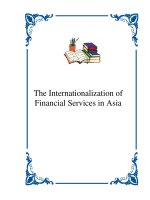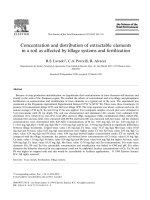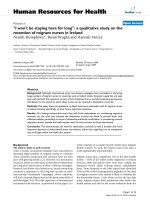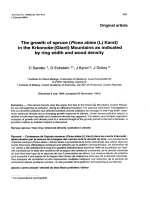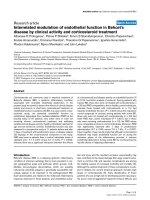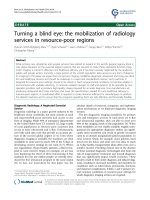The Marketing Of Tourism Services In Ireland As Represented By The Hotel And Catering Industries
Bạn đang xem bản rút gọn của tài liệu. Xem và tải ngay bản đầy đủ của tài liệu tại đây (5.77 MB, 341 trang )
THE MARKETING OF TOURISM SERVICES IN IRELAND
AS REPRESENTED BY
THE HOTEL AND CATERING INDUSTRIES
Thesis Submitted for the Award of
M.B.S.
(Master of Business Studies)
to the
DUBLIN CITY UNIVERSITY BUSINESS SCHOOL
Dublin City University
by
Malcolm Mitchell
Supervisor:Professor Peter Chisnall
September 1993
DECLARATION
I hereby certify that this material,which I now submit for
assessment on the programme of study leading to the award of
M.B.S.is entirely my own work and has not been taken from the
work of others save and to the extent that such work has been
cited and acknowledged within the text of my work.
Signed.
Date. ..
..... .
Declaration
The present thesis 'The marketing of tourism services in Ireland
as represented by the hotel and catering industries1,is based on
the work undertaken by Malcolm Mitchell,post-graduate student
at the Dublin Business School,Dublin City University,during the
period September 1989 - September 1993. The research was carried
out under the supervision of Professor Peter Chisnall,Head of
Management Division,Dublin Business School,Dublin City University.
Signatu
^
ih Student
r
Signature of Supervisor
TO MAUREEN
ACKNOWLEDGEMENTS
I would like to thank the following people for their kind
assistance in the completion of this project.
*All of the participating managers in the respective hotels and
restaurants for their assistance in the survey.
*Professor Peter Chisnall,for his supervision,guidance and in
particular,his patience.
A SPECIAL ACKNOWLEDGEMENT
In this project I would like to acknowledge the liberty
that I have taken in referring regularly to the work of
Prof P.M.Chisnall and in particular his text;Marketing:
A Behavioural Analysis,2nd Edition,1985.McGraw Hill.
I have pleasure in stressing the importance of his works
and the deference due to him for his support,and kindly
ask his indulgence.
THESIS OUTLINE
This thesis is divided into four main sections.
The first focuses on the type and nature of services in the
context of services marketing,along with the process of service
and presents some conceptual frameworks by which services may be
identified. It looks at the development of the service
economy
and the historical background to the service industry in Ireland
in particular.
Consumerism is referred to in response to marketing activities
where there is cultural and social change-especially the growing
responsibilities of marketers in the face of consumer
sovereignty.
In order to satisfy consumer expectations and maximise marketing
effort,there is the need for interdependence of marketing
activities. Emphasis is maintained on the concept of
client-server interface and the management of the service
transaction.
The aspect of consumer decision making from a problem solving
approach is developed,from the basic black-box,to considering a
number of more complex logical or process-flow models,in an
attempt to explain consumer rationale for choice.
The second section returns to the theme of services in
Ireland,but is developed from a tourism perspective,
concentrating on the present structure of the industry, and
developing the theme of the importance of tourism to the Irish
economy.- in particular as a major revenue earner and
employer.The industry is broadly covered,highlighting the main
sectors of which it is composed.
The third section outlines the area of research surveys in
general and the format which was used with this project,including
rationale and main methodology.
The fourth and final section covers the research proper and
details of the findings,along with some tentative comments where
thought appropriate.
TABLE OF CONTENTS
SECTION 1
1.1
Introduction to Services
1
1.2
Nature and Types of Services
6
1.3
Definition
7
1.4
Development of Services
18
1.5
Services - Ireland
21
1.6
Consumerism
30
1.7
Interdependence
38
1.8
Consumer Decision Making
49
1.9
The Model Process
57
SECTION 2
2.1
The Research Problem
69
2.2
The Tourism Industry
80
2.3
Tourism - Value to the IrishEconomy
84
2.4
Tourism Classifications
103
2.5
Tourism Industry - Employment
110
2.6
The Irish Hotel and CateringIndustry
2.7
Non-Food Accommodation Sectors
2.8
Leisure Centres
H4
118
1
SECTION 3
3.1
Desk Research
123
3.2
Research for Services
125
3.3
Sample Design
126
3.4
Form of Sample
129
3.5
Sample Size
132
3.6
Questionnaires
133
3.7
Survey method
134
SECTION 4
4.1
Aim of Research
135
4.2
Research Findings
137
4.3
Summary of Findings
202
APPENDICES
ABSTRACT
The vulnerability of Irish business stems from their tendency to
rely on single products or market characteristics for
success,instead of developing a comprehensive marketing strategy
Desk research was undertaken in order to develop a better
understanding of services marketing and create a background of
the tourism industry.
The nature of services was identified,as well as the processof
the development of Irish services,along with the increasing
dependence on services for employment. The influence of
consumerism and decision-making was also studied.
Primary research focuses on the Hotel and Catering industry,with
specific reference to the ways these two segments pursue their
marketing strategies.
It was found that the majority of problems confronting the two
are as a result of the scale of operations vis.a highly
fragmented industry which suffers from the lack of professional
marketing skills. The main trade and professional associations
do not appear to be meeting the needs of the typical small firms
in hotel and catering in Dublin. It appears that the existing
organisations have failed to fill this gap and it is recommended
that a special initiative should be made to provide small firms
in the hotel and catering industry with relevant professional
marketing expertise.
THE MARKETING OF TOURISM SERVICES IN IRELAND AS REPRESENTED
BY THE HOTEL AND CATERING INDUSTRIES
INTRODUCTION
Services of all types are taking an increasing part of both
organisational and personal budgets.Strategies and tactics in the
marketing services are being applied in many different ways from
those typically applied to products (Wilson 1972.1).
The array of services is a bewildering jumble of size and
activities even to the extent as arising as the result of a
sideline of manufacturing industry (Westing & Albaum 1975.6).
But what constitutes a service market? Cooke describes it as "
a set of human wants sufficiently homogeneous that they may be
satisfied by a defined service offer" (Cooke 1972.2). In addition
to services are means not ends in themselves.
It is recognised that services marketing has its own unique set
of requirements and marketing opportunity has been enhanced by
regulatory change in certain professions
(medicine;law;accounting) as well as the increase in expenditure
in services generally.(Upah & Upah 1983.3).
1
Services marketing has been neglected for many reasons. The
organisations are small lacking in management expertise whilst
professional codes of practice have been antagonistic to the idea
of marketing - considering it to be unprofessional or even
unethical.(George & Barksdale 1974.4). Such an approach
indicating the lack of what actually constitutes marketing in
effect however indications of change of attitude are illustrated
by Airlines and Banking - the latter which moved from hostility
to aggressive marketing relatively quickly.
(Carroll 1970.5) .
From the outset of services marketing it was recognised that
service companies did not have a marketing approach resulting in
a failure to recognise or react to marketing problems or to
coordinate service marketing activities.(Johnson 1964.7). More
recently ::.t has been suggested that service firms are more likely
to lack a marketing department to perform analysis;consult
specialist marketing agencies;plan;train;research or finance
marketing activities.(Cowell 1984.8).
As will be seen the Irish service industry (represented
especially by Hotels and Catering) ,is singular in the size of its
individual companies. Many if not all marketing activities are
likely to be performed by one individual
who may have some
specialist training but whose main responsibilities lie in a
different area to marketing.
2
The foregoing may appear as a series of excuses rather than
legitimate reasons or explanations for service companies who
failed to adopt a marketing approach.(Dornstein 1977.9/Houston
& Homans 1977 .10;Hovell 1969.11) . However deregulation, the growth
of D.I.Y.,the rising costs of services and the growth of service
professionals will significantly increase the use of marketing
by service firms.(Evans & Berman 1987.12). Studies which
illustrate this growth are given in Banking(Stall 1978.13);the
Canadian Postal Service (Barnhill 1974.14);Utilities in the U.S.
(Warshaw 1962.15);and the Public Provision of Recreation and
Leisure Services (Cowell 1979.16)/Accounting services (Kotler &
Connor 1977 .17 ),-Prof essional Services in General (Wilson 1972
1)/Banking Services (Berry 1975.18;Rathmell 1974.19;Shostack
1977.20);Retail Services in General(Judd 1964.21;George
1977.22;Upah 1980.23);Transportation (Voughn et al 1979.24) and
the Performing Arts (Currim et al 1981.25).
Problems common to the service market have been addressed by
Sasser (1976.26),and Lovelock and Young (1977.27) regarding
supply and demand. Levitt (1977.28;1976.29) discusses
productivity while Sasser and Arbeit(1976.30) discuss structure
and mechanisation of service tasks. Production economies of
multisite operations are addressed by Chase (1978.31) and Upah
(1980.23) and Distribution channels by Donnelly (197 6.32) and
Stern and El-Ansory (1972.33).
3
In addition to the accepted public areas of health care education
and government, the topic of services also involves such areas
as finance personal and professional services.(Pride & Ferrell
1989.34). Traditional approaches to marketing have little to
offer the services sector (Gronroos 1980.35),but the marketing
concept is becoming increasingly appropriate for services (Watson
1982.36;Garret 1980.37;Waterworth 1973.38;Bellardo & Waldort
1977 .39). .While implementation of the marketing concept has been
documented by Kotler (1982.40);Bochner & Khosla
(1981.41),Mahon(1978.42),and Wahab et al (1976.43).
SUMMARY
Services are becoming more prevalent at both industry and
consumer levels. Service marketers lean heavily on the
established principles of product marketing possibly making
instinctive rather than conscious allowance for the particular
problems arising out of marketing a service.
In order to be able to apply the principles of marketing
obviously the right set of conditions must exist. In particular
the company must accept and implement its own marketing
philosophy - possibly a function of the size and type of
organisation.
4
The 'unique'requirements for the marketing of services may be
many and varied. This is as a result of the great variety
of services that exists. There is also the complication of the
operating traditions that are laid down by certain services particularly professional services. These traditions are likely
to not only to have been 'institutionalised but also assumed to
apply to the service by the consuming public. This may be
manifested as a certain business ethic - real or apparent rather
than depending on or based on the requirements of skill finance
or competition.
Changing market demographics culture technology and environmental
and political will have conspired to create the necessity for a
marketing re-appraisal on the part of service marketers in
particular to define more
closely the specific principles which would determine successful
marketing of their own particular service.
5
REFERENCES
1
.
Wilson A.1972.The Marketing of Professional
Services.McGraw-Hill.London
2
.
Blaine Cooke.1970.'Analysing Markets for Services'
from Buell V.P. and Heyel C. Handbook of Modern
Marketing. McGraw-Hill
3.
Uhl Kenneth P. and Upah Gregory D. 1983.'The Marketing
of Services,Why and How is it Different? Research in
Marketing.Vol.6 pp231-57 JAI Press Inc.
4.
George W.R.and Barksdale H.C. 1974 Marketing Activities
in the Service Industries. Journal of Marketing Oct.
5.
Carroll David T.1970 'Ten Commandments for Bank
Marketing'Bankers Magasine.Autumn.
6.
Westing J.Howard and Albaum Gerald.1975 'Modern
Marketing Thought'.3rd Ed.Macmillan
7.
Johnson E.M. 1964. An Introduction to the Problems of
Service Marketing Management. The Bureau of Economic
and Business Research. University of Delaware
8.
Cowell D. 1988 The Marketing of Services. Heinemann
9.
Dornstein M.1977.'Some Imperfections in the Market
Exchanges for Professional and Executive Services' The
American Journal of Economics and Sociology.
April .Vo.l.3 6 No2 ppll3-28
10.
Houston F.S.and Homans R.E.1977 Public Agency Marketing
-Pitfalls and Problems.MSU Business Topics.Vol 25
Summer pp3 6-40
11 . Hovell P.J. 1969 Applying the Marketing Concept to
Public Planning.British Journal of Marketing.No3 Autumn
12
.
ppl52-63
Evans J.R. and Berman B.1987 Principles of
Marketing.3rd Ed Collier Macmillan.
13 .
Stoll R.B. 1978 Marketing in a Service Industry.
Atlanta Economic Review.Vol 28 No3 ppl5-18
14.
Barnhall J.A. 1974 'Developing Marketing Orientation in
a Postal Service. Optimum No3 pp3 6-47
15.
Warshaw M.R. 1962 Effective Marketing-Key to Public
Utility Growth. University of Michigan Business Review.
Nov.ppll-20
16.
Cowell D.1979 'Marketing Local Authority Sport,Leisure
and Recreation Centres'Local Government Studies.
July/August pp31-43
17 .
Kotler P. and Connor R.A.Jnr.1977 Marketing
Professional Services. Journal of Marketing.
Jan.No 41 pp71-76
18.
Berry Leonard L.1975 Personalising the Bank:Key
Opportunity in Bank Marketing.Bank Marketing
April pp22-25
19.
Rathmell John M.1974 Marketing in the Service Sector.
Cambridge MA.Winthrop
20
.
Shostack G.Lynn 1977.Breaking Free from Product
Marketing. Journal of Marketing April No41 pp73-80
21.
Judd Robert C. 1964 The Case for Redefining Services
Journal of Marketing Jan. No28 pp58-59
22.
George William R. 1977 The Retailing of Services. A
Challenging Future. Journal of Retailing
Fall Vol.53 pp85-98
23.
Upah Gregory D. 1980 Mass Marketing in Service
Retailing. A Review and Synthesis of Major Methods
Journal of Retailing Fall No56 pp59-76
24.
Vaughn Ronold I,Arora Roj and Honsotia Behram.1979
Marketing Urban Transport Systems,A Look at the
Cognitive Structure of Users and Non-Users by Trips
Purpose. Working Paper,College of Business Admin.Nov.
25.
Currim Imram,Leimberg Charles B.and Willink Dick R.
1981. On the Design of Subscription Programs for
the Performing Arts Series.Journal of Consumer Research
26.
Sasser W.Earl 1976 Match Supply and Demand in Service
Industries. Harvard Business Horizons. June pp61-65
27.
Lovelock Christopher H.and Young Robert F.1977.
Marketings Potential for Improving Productivity in
Service Industries. In Pierre Eiglier,Eric Langeard
and Christopher H .Lovelock,John E.G.Bateson and
Robert F .Young,Marketing Consumer Services:New Insights
Cambridge.MA. Marketing Science Institute.ppl05-20
28.
Levitt Theodore 1972 Production-Line Approach to
Services.Harvard Business Review.Sept.Vol50 pp41-52
29.
Levitt Theodore 1976 The Industrialisation of
Service.Harvard Business Review.Sept.Vol54 pp63-74
30.
Sasser W.Earl and Arbeit Stephen P. 1976 Selling Jobs
in the Service Sector. Business Horizons June pp61-65
31.
Chase Richard B. 1978 Where does the Consumer Fit
in a Service Operation? Harvard Business Review
Nov-Dee.ppl37-42
32.
Donnelly James H. Jnr. 1976 Marketing Intermediaries
in Channels of Distribution for Services. Journal
of Marketing Jan.Vol40 pp55-57
33 .
Stern Louis W. and El-Ansory Adel H. 1977
Channels .Englewood Cliffs. New Jersey
34.
Marketing
Prentice Hall
Pride William M. and Ferrell O.C. 1989 Marketing,
Concepts and Strategies 6th Ed.Houghton Mifflin
35.
Gronroos C. 1980 An Applied Service Marketing Theory,
Working Paper No57;Swedish School of Economics and
Business Administration.Helsinki
36.
Watson 1.1982 The Adoption of Marketing by the
English Clearing Banks in Turnbull P. and Lewis B.
(Eds), The Marketing of Bank Services, European
Journal of Marketing Vol.16 No3
37 .
Garret B. 1980 Marketing Architectural Services.
The Architects Journal March 12
38 . Waterworth D. 1973 Banks Behind Bars.Marketing.Nov.
39.
Bellardo T.and Waldhart T. 1977 Marketing Products
and Services in Academic Libraries. Libri Vol27 No3
Sept.
40.
Kotler P. 1982 Marketing for Non-Profit Organisations
Prentice Hall. Englewood Cliffs
41.
Bochner J.P. and Khosla N.K. 1981 Marketing and
Promotion for Design Professionals. R.E.Krieger
Huntingdon N.Y.
42.
Mahon J.J. 1978 The Marketing of Professional
Accounting Services J.Wiley & Sons N.Y.
43 . Wahab S.,Crampon L.J. and Rothfield L.M. 1976
Tourism Marketing Tourism International Press
NATURE AND TYPES OF SERVICES
"Spending in services continues to increase while still service
definitions remain imprecise".(Chisnall 1985.1). Service has been
identified as a transformation operation with inputs and outputs
(Lovelock 1979.2). On the other hand
Christopher et al (1980
3);consider the matching of organisational resources with
customer wants while Levitt (1977.4) looked at the companys
ability .to win and hold customers.
The four P's presented by McCarthy (1968.5) as originally
compiled by Borden (1965.5) implied that the profit nature was
paramount. Comparing the performance of services e.g.
health;education etc(Cowell 1984.7), Boom and Bitner extended
this list to include seven P's;
product;place;promotion;price;physical evidence;process and
people.(Boom & Bitner 1981.8)
The specific mix adopted will vary depending on organisation and
market dynamics.Either way the service will be sold as the core
of the companys market offering (Shostack 1977.9;Gronroos
1978.12) and that as a result various systems of
men,materials, capitol, equipment, information and money will be set
to accomplish some identifiable set of objectives (Vollman
1973.10),both in non-profit and for-profit marketing (Pride &
Ferrell 1989.11).
6
The service package consists of physical resources,materials
used,standards of performance and benefits derived all of which
are experienced by the consumer and give rise to varying degrees
of satisfaction/dissatisfaction. The difficulties arise where the
service element tends towards the 'pure' or to dominate the
service-product mix.(Uhl & Upah 1983.13).
The boundary between goods and services is still difficult to
draw.(Fuchs 1965.14). An early approach was to look at the
special market conditions demanded by services.
(Eiglier &
Langeard 1977.15;Judd 1964.16;Rathmell 1974.17;Uhl & Upah
197 8.18). Many assumptions previously held as to services were
variously criticised (Bonoma & Mills 1979.19;Wyckham et al
1975.20;Sheth & Garret 1986.21). To argue differences between
products and services was considered unproductive (Ryans &
Willink 1977.22),rather it would be better to consider the
problem from the point of view of a strategic planning model. (Uhl
& Upah 1983.13).
DEFINITION
"Services are those separately indefinable essentially intangible
activities which provide want satisfaction and that are not
necessarily tied to the sale of a product or another
service"(Cowell 1984.24). To produce a service may or may not
require the use of tangible goods. However where such a use is
required,there is no transfer of title (personal ownership) to
those tangible goods.(Stanton 1981.25).
7
This concept of intangibility is centred upon by a number of
authors;(Kotler 1982.26;Levitt 1981.27;Ziethaml 1981.31);while
Christopher (1980.28) considers services as producing a series
of benefits which cannot be stored.
Wilsons definition ignored the concept of tangibility totally
(Wilson 1972.29) while Shostack (1982.32) was critical of this
emphasis on tangibility, attributing it as the reason why so many
services go awry. Bateson (179.33) cited the concept of
intangibility as the 'difficulty consumers may have in
understanding the service offerings' and who considered
tangibility to be the critical characteristic distinguishing
products from services.
(Bateson 1977 34). Specifically services cannot be
touched,standardised,owned,patented, separately identified from
production,inventoried or be considered exclusive from middlemen
( where applicable) or consumer.An attempt to overcome
intangibility was to focus on tangible clues i .e .specifying
previous jobs undertaken,the service given and benefits obtained
(Hardy & Davis 1983.35).
It is the benefits of the product not its features which is the
focus of marketing (Enis & Roering 1981.36;Brookes 1988.39),but
the direct,positive influence of intangibility on
customers,product benefits and marketing practices cannot
be underestimated (Rushton & Carson 1989.37),as well as being a
possible negative contributor (George 1977.38).
8
The need to emphasise tangibility in its various aspects has been
well documented,namely Advertising (Shrimp & Dyer
1978.40;Shostack 1977.9;Smith & Myer 1980.41);Physical
Surroundings (Berry 1975.42;Eiglier & Langeard 1977.15;Shostack
1977.9);the Importance of Public Contact Personnel (Berry
1975.42;George 1977.38;Sasser & Arbeit 1976.40). The areas of
advertising and promotion are particularly highlighted (Bloom
1977.44;Shrimp & Dyer 1978.40;Smith & Meyer 1980.41;Uhl & Upah
1983.13) .
PERISHABILITY
"Services perish generally at the very instance of their
performance"
(Cowell 1984.7) In services marketing,close
coordination of production capacity with market demand is
required to offset problems caused by the inability to store
services (Sasser 1976 45.). To compensate for
perishability,service capacity can be adjusted according to
variable demand,but it cannot be recalled for future use (Kotler
1986.46).
TRANSPORTATION OF SERVICES
Most services cannot be produced in one place and then
transported to another. Either the consumer must go to the
production facility or visa-versa,with obvious implications for
the service locations (Uhl & Upah 1983.13). This requires that
decisions have to be taken on capacity levels and demand surges
(Van Doren et al 1985.47).
9
